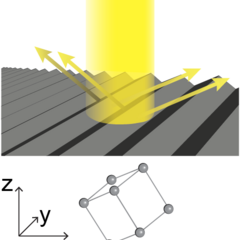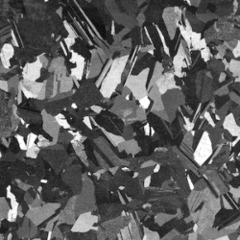Advanced Optical Microscopy
Directional Reflectance Microscopy (DRM)

Chemical etching produces arrays of faceted pits with geometries that follow the underlying crystal lattice orientation. If their size is large enough, these facets reflect light in a specular manner, as if they were microscopic mirrors (see figure on the left). As a result, grains with different crystallographic orientation (and thus different arrangement of etch-induced facets) will produce specular reflections along different angles. That is what we call "directional reflectance", which is the very same property that first allowed to see and analyse the microstructure of solids using light microscopy in the early 1860s.

By measuring the directional reflectance of grains, it is possible to reconstruct the local surface topography and, in turn, map the orientation of the underlying crystal lattice across the sample surface in a similar way to diffraction-based techniques (e.g., electron backscatter diffraction). Building on this principle, directional reflectance microscopy (DRM) captures a series of optical micrographs from an etched crystalline solid under varying illumination angle (see animated gif on the right). To compute crystallographic orientation, we compile the acquired directional reflectance into “directional reflectance profiles”, which we then analyse using either analytical or machine learning models (depending on the complexity of the signal).
DRM brings many advantages to microstructure characterisation of crystalline solids. Because it relies entirely on optical microscopy, DRM comes with a much lower price tag compared conventional diffraction-based techniques. Moreover, DRM requires no vacuum and thus has no restrictions whatsoever on sample size. We are also currently exploring the possibility of acquiring orientation information from non-flat surfaces. The combination of these benefits—on cost, sample size, and sample geometry—make DRM most attractive for non-destructive, routine microstructure analysis of life-sized engineering components. The high measurement throughput provided by DRM makes it also a candidate technique to study the causes that drive large-scale microstructure heterogeneity in metal additive manufacturing.
We are now exploring commercialisation pathways for DRM in collaboration with NTUitive in Singapore. More details about these activities can be found in the sidebar.
